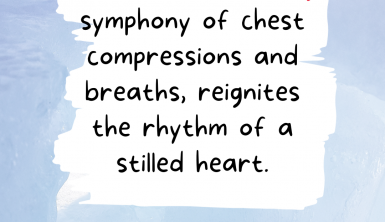Cardiopulmonary Resuscitation, better known as CPR, is a lifesaving measure done in the event of sudden cardiac arrest. Cardiac arrest occurs when the heart stops beating. The heart beats in order to pump life-giving oxygenated blood throughout the body. CPR intervenes to pump the heart and keep blood distributed.
Two Steps To Save A Life
When sudden cardiac arrest strikes, know these two steps:
- Call 911. Calling for professional medical help begins their response time. A faster response increases the chances of survival and even quality of survival.
- Compress hard and fast in the center of the chest. Compression-only CPR is better than no CPR.
How to Give CPR
Proper CPR is a pattern of 30 chest compression and 2 rescue breaths. Proper form for administering compressions is placing the heel of one hand to the chest and using body weight to rock back and forth. The chest should compress and fully recoil before the next compression. The 30 compressions should be delivered in the center of the chest. The center of the chest can be found between the nipples or where the ribs begin to come together at the end of the breastbone. Compressions should be given at a fast pace of 100-120 beats per minute reaching a depth of 2 inches.
Rescue breaths are effective with a head-tilt chin-lift motion preparing the patient’s airway to receive 2 steady 1-second breaths. This specific formula of compressions and breaths can be used on patients 8 years and up. When giving CPR to smaller patients, the beats per minute are reduced to 100 and the depth reduced by a half inch. Rescue breath instructions remain the same for any age, with special consideration for smaller patients. Consider, it takes less air to fill a child’s lungs so the volume should be reduced than that for an adult. A good measure of rescue breath effectiveness is seeing a rise in the chest.
Who Can Give CPR
CPR has simple enough steps to learn, but is physically demanding for the rescuer. Due to the simplified nature of instructions, a wide range of ages can perform CPR. Ages 8 and up are most likely to deliver CPR successfully. A wider range of ages, even including the very young, can still assess a situation and identify breathing or consciousness.
CPR with AED
CPR is a major contributing factor to a victim’s survival rate. Use of an AED along with CPR can further increase the chances of survival. AED, or automated external defibrillator, is an electronic tool used to detect the heart’s rhythm and deliver electric shock if needed. In cases where a shock is needed, it can prompt the heart to resume effective beating. AEDs require training for proper use, but are designed with a high level of user friendliness in balance with effectiveness for the victim.
CPR Facts To Know
- Nearly 70% if sudden cardiac arrests occur at home.
- Many family members or caregivers struggle with the decision to begin CPR.
- Administering CPR swiftly can as much as triple the survival rate for the cardiac arrest victim.
- Repeated CPR training is best to maintain sharp CPR skills.
CPR explained in 140 characters
#SCA emergency? Begin CPR: 30 compressions, 2 breaths. Compressions hard & fast. Head tilt, chin lift to deliver breath. 30:2. 30:2. 30:2.
CPR needed? CHECK: patient. CALL: 911. CARE: begin CPR. 30 fast compressions mid chest. Head tilt/chin lift to give 2 breaths. Repeat 30:2.
First Aid explained in 140 characters
First thing to know about First Aid: it gives help to those when they need it most. Be the difference. Don’t be unaware, show them you care.
Relieve choking, stop the bleeding, support the injured. First Aid takes many forms. Show you care, begin First Aid until medics are there.
Clean a wound. Give CPR. Ice the pain. First Aid has many forms & effects anyone. Provide First Aid and provide the first step of treatment.
References
https://journals.plos.org/plosone/article?id=10.1371/journal.pone.0202430
https://www.ahajournals.org/doi/full/10.1161/CIR.0000000000000539
https://www.tandfonline.com/doi/full/10.1080/10803548.2018.1502962
https://www.heart.org/-/media/data-import/downloadables/pe-abh-what-is-an-automated-external-defibrillator-ucm_300340.pdf
Want to Learn More?
We offer online CPR and First Aid courses and you can also obtain your certification online. And yes, National CPR Foundation is legitimate. Checkout our courses below:
Standard - CPR /AED
Only $12.95 18.95
CPR - Adult / Pediatrics
Automated External Defibrillator (AED)
Valid for 2 Years
Standard – First-Aid
Only $12.95 18.95
Injury Prevention
Universal Precautions
Valid for 2 Years
CPR / AED / First-Aid
Only $14.95 20.95
CPR – Adult / Pediatrics / First-Aid
Automated External Defibrillator (AED)
Valid for 2 Years
Bloodborne Pathogens
Only $9.95 18.95
Infectious Disease Control
Best Practices / Precautions
Valid for 1 Year
Healthcare – CPR / AED
Only $12.95 19.95
CPR – Adult / Pediatrics (Choking)
Automated External Defibrillator (AED)
Valid for 2 Years
Basic Life Support (BLS)
Only $14.95 24.95
CPR – Adult / Pediatrics (Choking)
AED / First-Aid
Valid for 2 Years







